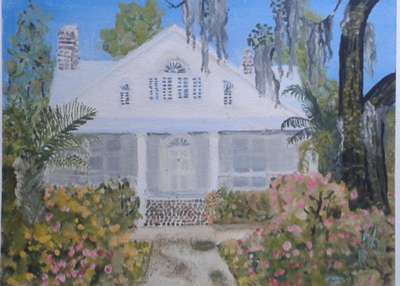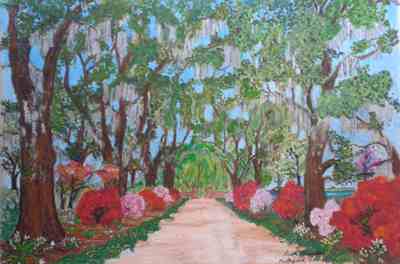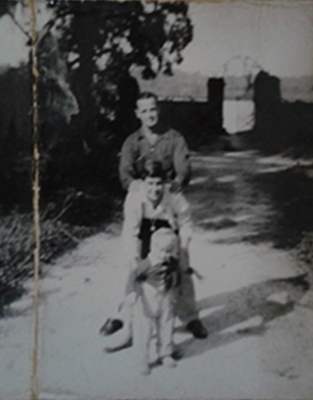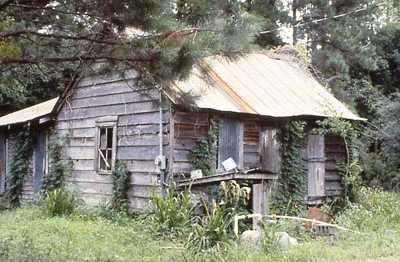Keithfield Plantation – Georgetown – Georgetown County
Basic Information
- Location – Black River, Georgetown, Georgetown County
Located southeast of US 701 in the vicinity of Keithfield Drive
- Origin of name – Named for John Keith, an early owner
- Other names – Woodford (3, p. 449)
- Current status – ?
Timeline
- 1734 – Earliest known date of existence
John Green received a grant for 500 acres on the north side of the Black River (3, p. 447).
- ? – House built
- 1750 – John Green died and willed the property and "all the Buildings and Improvements thereon" to his son Richard (3, p. 447).
- 1754 – There had been some issues with John Green's will. In order that Richard would have a 'clean' deed to the property, his brother William conveyed the property to Richard in July (3, p. 447).
- 1764 – Richard Green and his wife Margery conveyed the 500 acre tract to William Jamieson. Jamieson received a grant for 35 acres of marsh that adjoined the 500 acre piece. Jamieson would purchase an additional 120 acres of adjoining property from James Crokatt's Ingleside Plantation (3, p. 447).
- 1766 – Jamieson died dividing his holdings between his wife Mary Cantey Jamieson and his sister Agnes Stitt. Agnes received the Black River plantation (3, p. 448).
- 1768 – Agnes conveyed the plantation to her son William Stitt (3, p. 448).
- Circa 1794 – Stitt had died sometime prior to this as his niece Agnes and her second husband Robert Kirkpatrick sold 882 acres to James O'Hear (3, p. 448).
- 1797 – John Keith owned the plantation (3, p. 448).
- 1824 – John Keith arranged to sell Keithfield to Richard O. Anderson on January 1. Keith died shortly before the transaction. Anderson also owned neighboring Ramsay Grove Plantation (3, p. 448).
- 1852 – Anderson died (3, p. 449).
- 1853 – James Heyward Trapier purchased the plantation from Anderson's estate (3, p. 449).
- 1865 – Trapier passed away in December. Keithfield continued to cultivate rice while being held in his estate using freedmen labor (1, p. 3).
- 1866 – One of the most intense freedmen uprisings in Georgetown County occurred at Keithfield. The freedmen left their work in the rice fields, chasing the manager off the plantation (1, p. 3).
- 1869 – Unable to farm Keithfield, the plantation was foreclosed on. Jane Lynch Pringle along with her sons John Julius Pringle and Dominick Lynch Pringle purchased Keithfield for $33,000 (3, p. 450).
- 1870-1873 – James R. Pringle & Son owned Keithfield (5).
- 1873 – James R. Pringle & Son transferred ownership of the plantation to Adger & Son (5).
- 1885 – John P. Hazzard acquired Keithfield and continued to grow rice at the plantation (1, p. 3).
- 1906 – Several severe storms forced Hazzard to end his commercial rice production at Keithfield. Hazzard then rented portions of the fields to black farmers who grew rice and sold their crop to local merchants until the 1920s. Descendants of these families resided on Keithfield in the 1960s (1, p. 3 and 4).
- 1915 – Julia Kaminski acquired the plantation from the Hazzard estate. She painstakingly restored the expansive gardens and cottage. The cottage faced the river and the interior walls were 4' x 8' cypress panels salvaged from the plantation's slave cabins. The original brick house had been lost to fire sometime prior to this (3, p. 450 and 6).
- 1936 – Julia Kaminski passed away leaving the plantation to her son Harold Kaminski (3, p. 450 and 6).
- 1947 – Dr. Hal B. Holmes purchased 300 acres including the house from Kaminski (3, p. 450 and 6).
- 1956 – Westray Battle Hazzard purchased Keithfield Plantation from Holmes. At time of purchase, the cottage did not have electricity or plumbing. Westray's brother, Jack Hazzard, owned Wedgefield Plantation located across the Black River from Keithfield. Hazzard remodeled the old kitchen building for use as a guest cottage (3, p. 450 and 6).
Ruth Hazzard shares, "After purchasing Keithfield my father [Westray Battle Hazzard] had my brother, Harvey, help Abe Pyatt, caretaker, load the bricks from the old house on a flatbed truck to be taken to Georgetown for sale. The load was too heavy for the old bridge, it fell through into the canal close to the river. A barge had to come from town to pull it out of the water. Some of the bricks were never recovered, but the bridge still stands, strong and secure."
- 1957 – The cottage was destroyed by fire (and 6).
- 1959 or 1960 – Westray Battle Hazzard sold the plantation to L.H. Hutton. A stipulation of the sale was that Abraham Pyatt would continue to reside at Keithfield until his death. Abraham had lived on the plantation since the early 1900s and passed away in 1967 (3, p. 450 and 6).
- 2001 – The Hutto family still owned the plantation (3, p. 450 and 6).
Land
- Number of acres – 500 in 1735; 535 in 1764; 882 in 1794; 300 in 1947 (3, p. 447-450)
- Primary crop – Rice (1, p. 2)
- Elizabeth Jaquette Bond's father was hired around 1937 to care for the grounds of Keithfield. Elizabeth recalls from her childhood, "The plantation was actually and island - as the river was on one side and rice irrigation canals surrounding it on the other sides. You had to cross a bridge on the canal to get onto the property. The plantation was then considered a "show place", and around Easter time, when the flowers and trees were most beautiful, "guests" were allowed to take guided tours around the grounds. The "tour guides" were my brothers, who would hop onto the runningboards of the cars and take them all around the winding driveways. They would point out special trees and flowers, and tell about the history of the plantation. This was a free tour, but most people tipped them a little for their service. At the end of a tour, the "guests" were invited to stop and have lemonade and cookies made and served by my mother and sisters. A small brochure was given out with a picture of the house and gardens." (4)
- Ruth Hazzard shares, "My father [Westray Battle Hazzard] took great pride in Keithfield, developing extensive duck ponds in the old rice fields, putting in new trunks and restoring the dikes, and improving and keeping up the gardens." (6)
Slaves
- Number of slaves – 81 in 1860 (1, p. 3)
Buildings
- A circa 1830 slave cabin was on the property in 1987 (1, p. 3).
- Elizabeth Jaquette Bond resided in the house at Keithfield around 1937, before it was destroyed by fire. She remembers, "The house was very large, with a columned-porch on both levels. Sitting on the porch, to the left of the large double doors, was a very large, green, iron dragon. It frightened this four-year old child, who had many nightmares about it! [During a visit in 1964, Elizabeth found] sitting under a tree near where the house had stood, was that scary green dragon!" (4)
References & Resources
- National Register of Historic Places
– Nomination form - PDF - submitted in 1987
– Photographs, architectural overview
- George C. Rogers, Jr., The History of Georgetown County, South Carolina
(Spartanburg, SC: Reprint Company, 1990)
 Order The History of Georgetown County, South Carolina
Order The History of Georgetown County, South Carolina - Suzanne Cameron Linder and Marta Leslie Thacker, Historical Atlas of the Rice Plantations of Georgetown County and the Santee River
(Columbia, SC: South Carolina Department of Archives and History, 2001), pp. 446-450
 Order Historical Atlas of the Rice Plantations of Georgetown County and the Santee River
Order Historical Atlas of the Rice Plantations of Georgetown County and the Santee River - Information contributed by Elizabeth Jaquette Bond who lived at Keithfield as a child
- William Hay Townsend, Reports of Cases Heard and Determined by the Supreme Court of South Carolina, Volume 11 (Columbia, SC: R.L. Bryan Company, 1880) - Information contributed by John C. Keith
- Information contributed by Ruth Hazzard whose father owned Keithfield Plantation






